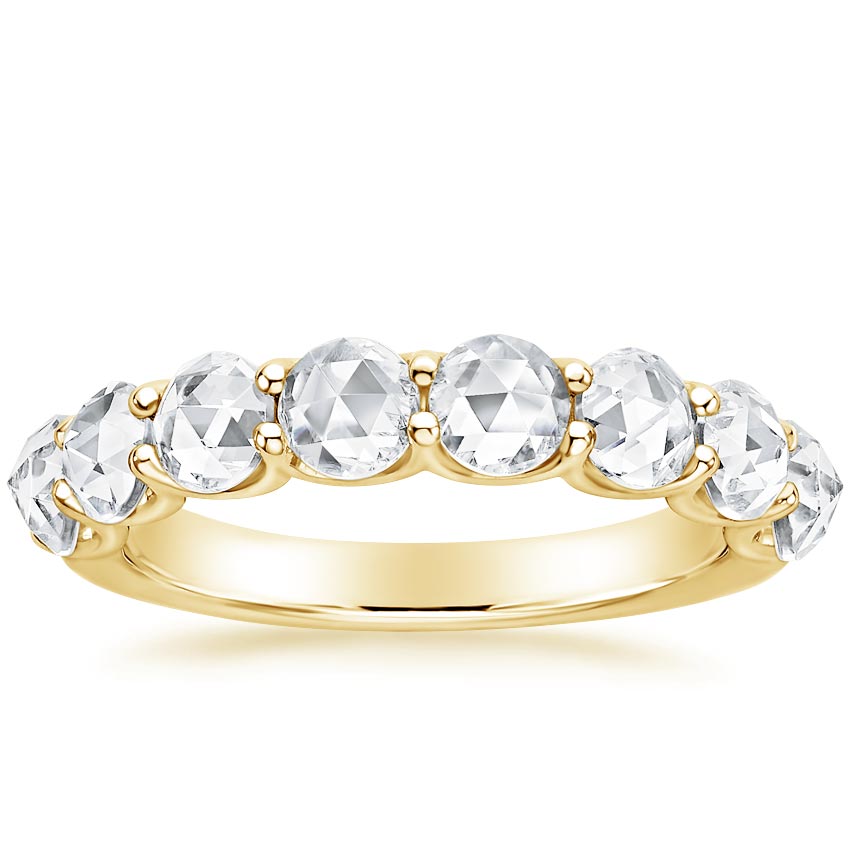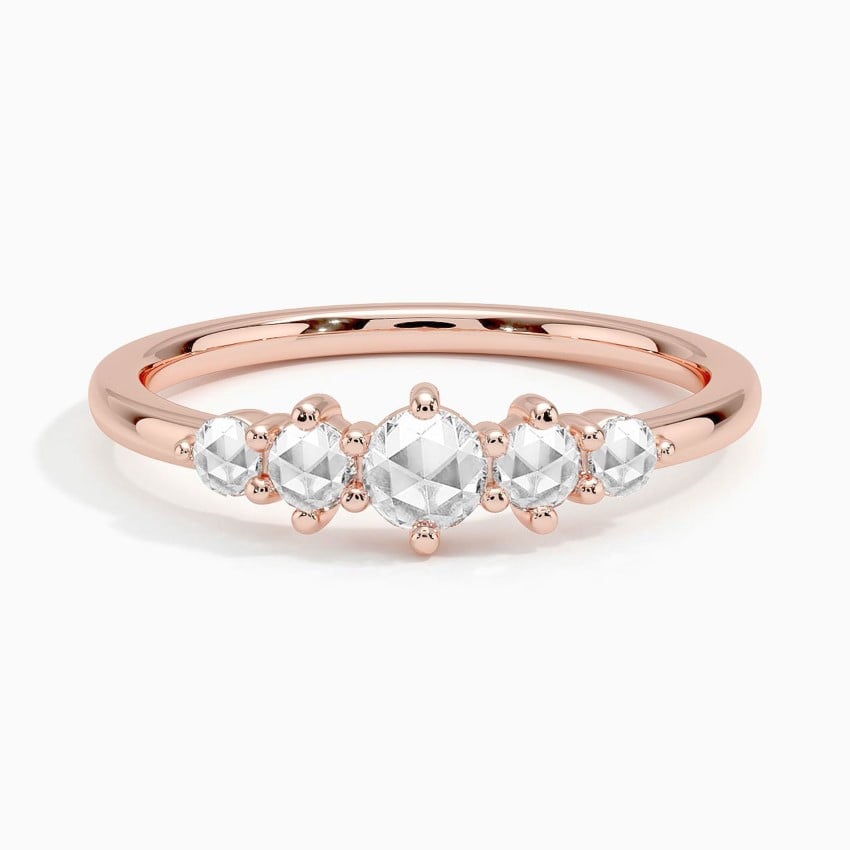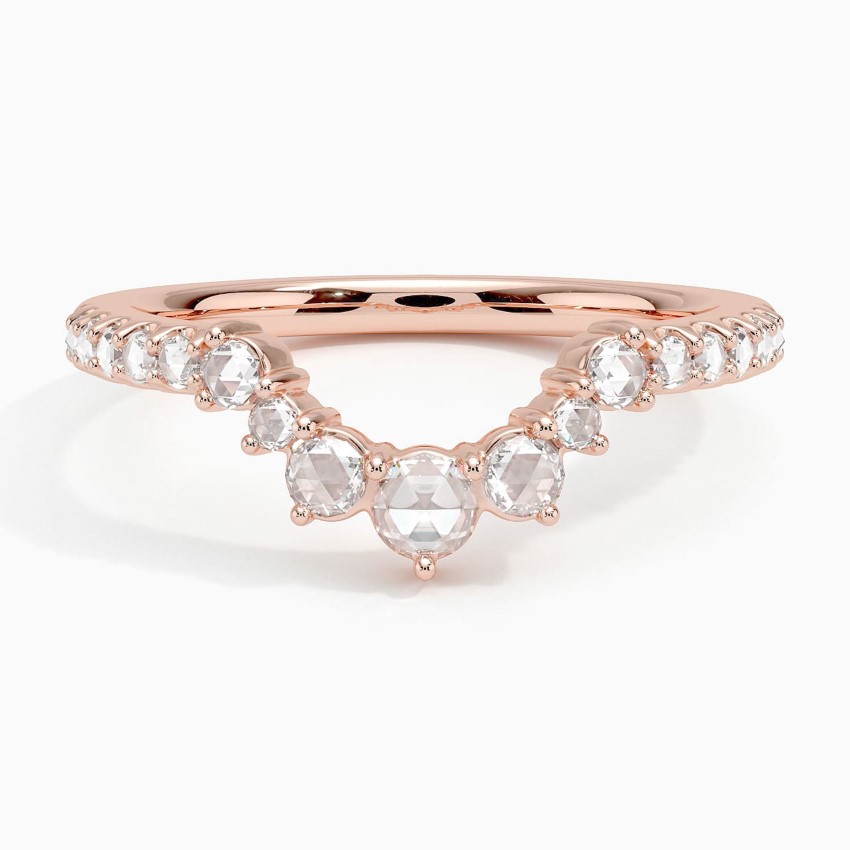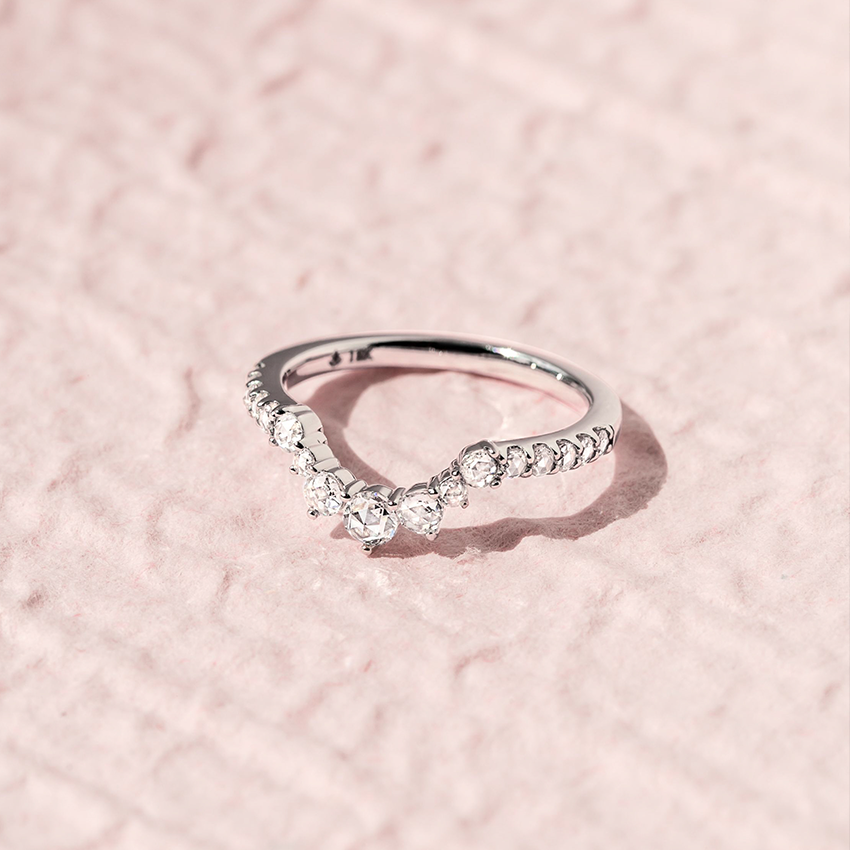
A rose cut diamond offers plenty of elegance beyond your years — it’s been around since the 1500s. You want romance? You got it. With its blooming sprawl of “petals,” this diamond cut is a bouquet and jewelry all in one, perfect for intimate engagement rings and wedding rings. Learn all about the rose cut diamond and how it got its whimsical floral flourish.
What is rose cut?
This is the diamond cut for old souls. With a peaked dome featuring fewer (bigger) triangular faces, it’s a rose-like spiral of antique elegance. Centuries old, this shape was meant to catch the glimmer of candlelight, which is why the low-key rose cut diamond is not absolutely covered in facets. Typically three to 24 facets make up its modest surface.
A rose cut has no pavilion, with nothing beneath its “girdle.” It doesn’t have the pointy bottom to create that classic conical body you usually picture when you think about the anatomy of ring. Instead, a diamond with a rose cut spreads, blossoming outwards. What you can see of the stone appears larger, especially from above, which means opting for this diamond cut’s flat base actually gets you more carat weight for less cost.
Maybe its most nostalgic feature, the rose cut is still hand carved, unlike modern diamonds whittled by a saw or laser. So if unique is on your list of priorities, the old-fashioned craftsmanship that goes into a rose cut’s grooves can make your diamond feel (even more) precious.
To recap: the rose cut is graceful, affordable, and one-of-a-kind. No wonder it’s trending and giving the ever-popular round brilliant cut a run for its money.
History of Rose Cut Diamond Rings
Though it’s one of the oldest diamond cuts, the rose cut’s prime is far from past. Historical flair is on the rise as people seek to stand out. Vintage vibes are an easy way to signify taste and style, so people are embracing the old-world glamour and mystique of this rose-bud-inspired design. Who else do you know that’s made a comeback after 500 years?
Popular in the mid-1500s, the rose cut took a back seat once the miner cut hit the scene in the 18th and 19th centuries. While everyone determines their own standards for quality and beauty in rings, the jewelry industry’s priorities shifted towards the brightest sparkle a gemstone has to offer. Shimmery won over subtlety, eventually establishing the dominance of the brilliant cut.
Experts found a way to help rose cut diamonds fake it ’til they make it, adding a thin layer of foil to the backing to reflect more light. Many rose cut diamonds have since been re-faceted to produce this shinier crown because of the jewelry industry’s emphasis on glitter.
If you find a rare rose cut that skips this façade, you have a truly valuable gem. A diamond that retains its original luster has bragging rights. It’s closer to its roots in the Georgian and Victorian eras, capturing a lot we crave from the 16th century: simplicity, delicacy. Measured and cut by hand, the allure of the rose cut diamond is its understated alternative to traditional diamond cuts.

Pros of Rose Cut Diamonds
- Rose cut diamonds seem bigger than brilliant cuts. With a flat bottom, more of a rose cut’s carat weight is facing up. You’re getting the look of a larger diameter, even compared to a brilliant cut gem with the same diamond carat weight (or sometimes even twice that). So you’re spending less for the appearance of more.
- They’re unique. While rose cut diamond engagement rings are on the rise, only 0.1% of new diamonds are destined for a rose cut. Most rose cuts are going to be vintage, so you know you’re getting a one-of-a-kind gem that glistens with sentimental longing.
- Rose cut diamonds come in any diamond shape and many sizes. So if you do customize a modern gem, you can trim your “petals” to fit your personality.
- Rose cut diamonds are typically more affordable. Antique rings, however, will be more expensive.
- Rose cut diamonds are convenient for active lifestyles. The flat base means the diamond is less prominent so it’s more protected.
Cons of Rose Cut Diamonds
- Rose cut diamonds don’t have as much sparkle. Without a pavilion (essentially, a stage), the gem doesn’t allow for much “fire.” In other words, the flat base prevents much light from reflecting back.
- The hand carving of the rose cut will lead to tiny imperfections. But if you embrace quirky idiosyncrasies, then a little bit of asymmetry can be extra special instead of a deal breaker.
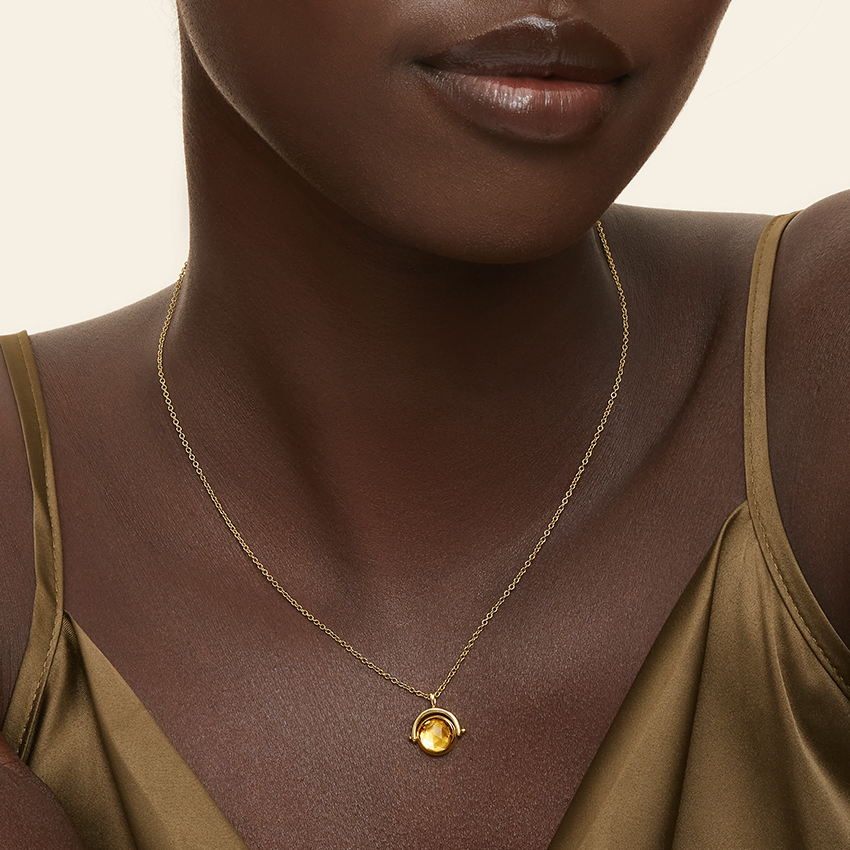
Brilliant vs. Rose Cut Diamonds
- Most rose cut diamonds are chic antiques, while brilliant cuts are fashionably modern.
- Rose cuts boast handmade charm, whereas brilliant cuts are shaped by lasers and celebrated for precision.
- Rose cut diamonds are harder to come by, while brilliant cuts have enjoyed a long reign as the most popular style of engagement ring.
- Rose cuts have a glassy luster. Brilliant cut diamonds have a flashy sparkle.
- Rose cuts have a flat base so they appear larger on top than brilliant cuts with the same carat weight. But the pointy bottom of a brilliant cut reflects more light.
- Rose cut diamonds are more affordable, but the price of a brilliant cut is what you pay for symmetrical “perfection.”
Evaluating Rose Cut Diamond Rings
1. Facets
Originally intended to shimmer by candlelight, the number of facets was suited to each stone to bring out its best glow.
2. Outline Symmetry
As a handcrafted piece, part of the rose cut’s charm is how its facets don’t line up just so, leaving traces of the artist’s touch. Not exactly lopsided, it’s a little more like a crooked grin.
3. Dome
Rose cuts have the reverse diamond shape you’d expect: flat on the bottom and domed up top. The lack of depth in a rose cut dims its brilliance.
4. Color
Diamond color is helpful in rose cuts for hiding imperfections. The lower level of brilliance is an attractive match for warmer tones (think yellow or champagne) and more subversive colors (including black or salt & pepper).
5. Clarity
Rose cut diamonds have a weaker shine (and clarity) because they don’t have a pavilion. Less glisten means more transparency, so you’re able to see more inclusions, or “flaws.” If you embrace character, then you might marvel at the unique size and placement of your gem’s imperfections. And unlike inclusions in other stones, they won’t cause breakage.
6. Brilliance
A rose cut stone is not super shiny because it sits low. Its draw is its history and softness, not a dramatic “look-at-me” sparkle. If you want to flaunt, seek a modern gem with more facets.
How to Take Care of a Rose Cut Diamond Ring
It’s easy to avoid scratching with a rose cut, which has a low profile. And there’s not much of a shine to prevent it from dulling. So maintaining a rose cut diamond is quick and easy: wipe with a cloth and wash with mild soap. See our Diamond buying guide for more tips on preserving your gem’s integrity.
Our Favorite Rose Cut Diamond Rings
Rosada Rose Cut Diamond Ring (1 1/5 ct. tw.)
Rose Cut Diamond Ring (1/3 ct. tw.)
Rose Cut Three Stone Diamond Engagement Ring
Rose Cut Contoured Diamond Ring (1/4 ct. tw.)
Petite Shared Prong Rose Cut Diamond Ring
Elongated Luxe Flair Rose Cut Diamond Ring
Rose Cut Diamond Ring FAQs
Are rose cut diamonds more expensive?
Antique diamonds will cost more for their “period piece” status, but typically rose cut diamonds cost less than modern cuts with the same carat weight, all while appearing larger.
When did jewelers stop using rose cut diamonds?
Once the jewelry industry prioritized a gem’s shine in the early 1900’s, brilliant cuts began being favored for their sparkle.
What is a 1 carat rose cut diamond worth?
Rose cut diamonds are rare, so their pricing doesn’t have an average. But they typically cost half as much as brilliant cut diamonds with the same carat.
Do rose cut diamonds look bigger?
Yes! They’re flat below the belt, so they spread their weight by width. You could say they’re “bottoms up.”
What are the best ring setting for rose cut diamonds?
As a vintage cut, an Edwardian or Victorian setting will give it additional heirloom, collector’s item appeal. On the other “hand,” a modern setting, such as a bezel, will make your gem more durable.
Are rose cut diamonds durable?
With a proper protective setting, such as a bezel or halo. Keeping in mind that a rose cut carries its weight on top, you don’t want to expose them with standard prong settings. The edges will chip.
Do the 4 Cs apply to rose cut diamonds?
Not exactly. As an antique, rose cuts are built differently. Their facets are bigger, aka more transparent, so flaws are more readily visible. To avoid this, you’ll want a higher clarity or a warm color. It’s actually tough to find a colorless rose cut.
Final Thoughts
Does the flower power of a rose cut diamond speak to you? If you or your partner adores a vintage vibe, shop your rose cut at Brilliant Earth for ethically sourced jewelry.
Interested in learning more about diamonds? Check out our other Diamond Guides: Diamond Cut, Diamond Clarity, Diamond Carat, Diamond Color, Diamond Shape, Lab Grown Diamonds, Moissanite vs. Diamond, Moissanite vs. Lab Diamond, Cubic Zirconia vs. Lab Diamond, How Are Lab Grown Diamonds Made?, MM to Carat


